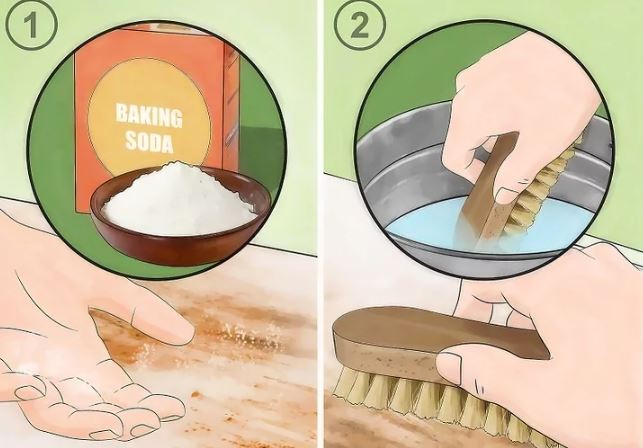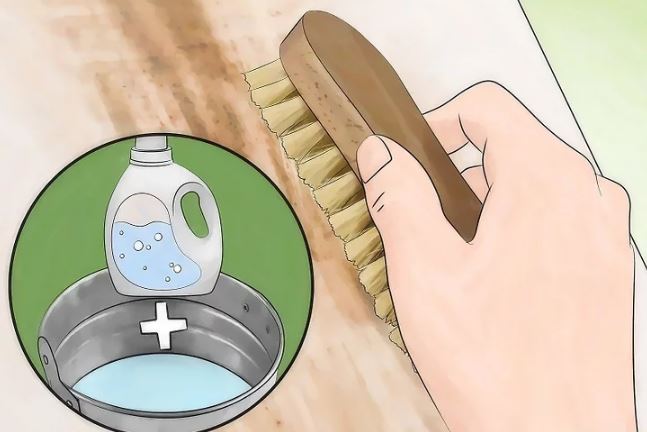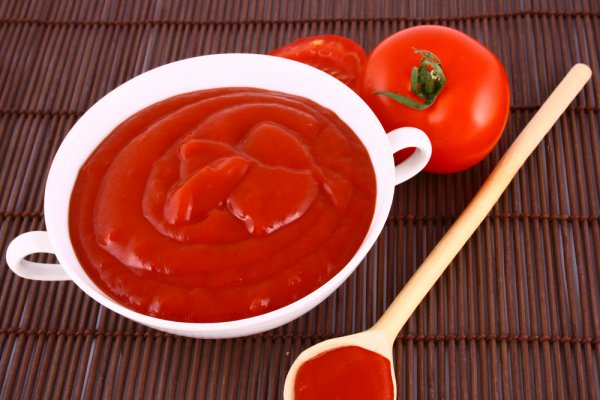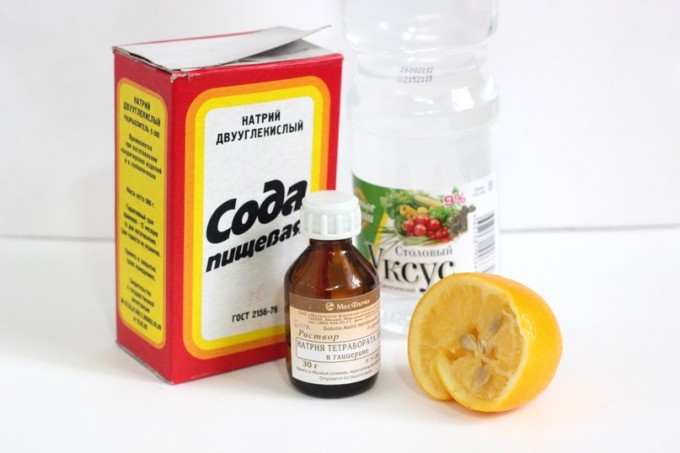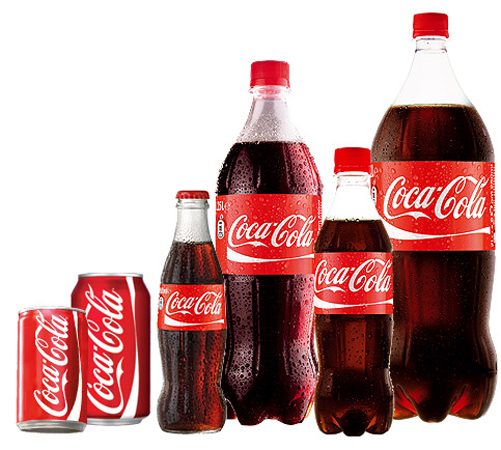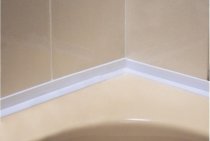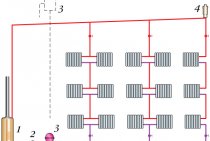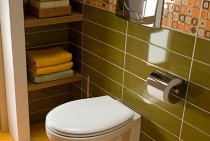Means and methods for cleaning bathtubs
- products sold in hardware stores and specially designed for cleaning bathtubs (however, you need to be very careful when choosing them, since some of them appear on the bottom of the bathtub and peel off the enamel);
- mustard powder, which also has antiseptic properties (a very quick cleaning method);
- wash off soft dirt from the walls of the bath with a wet nylon stocking, then use the same stocking to lather the bath with laundry soap and wash off this soap after 1-2 hours (preferably the next morning);
- soap-kerosene emulsion, which is a mixture of 20 g of liquid soap and 100 g of kerosene.
It is advisable not to soak the laundry in the bath and wash it with strong bleaches.
All faucets supplying water to the bath must be in good condition and prevent leaks and dripping of water into the bath, as this is the main cause of rust stains and glandular formations in the bath.
Rust Prevention
In order for the cleaned bath to retain its cleanliness and whiteness for a long time, follow simple preventive measures:
- Install filters to purify tap water.
- Regularly carry out preventive cleaning using improvised or professional tools.
- Start removing rust as soon as you find it, preventing the stain from growing.
- Use safe cleaning products that do not damage the finish.
- Wipe the bathroom dry at the end of the day.
- Avoid mechanical damage to the coating in order to preserve the beauty of the bath as long as possible.
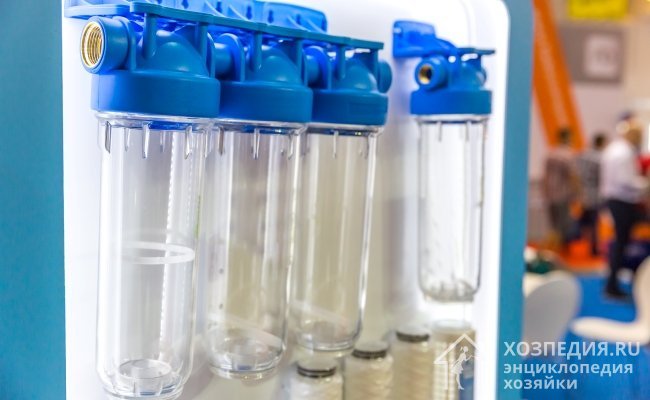
Using the methods and tips presented, it is not difficult to clean the bath from rusty deposits. The main thing is to consider the type of coating and do not use aggressive substances or products with abrasive particles.
Why does rust appear on plumbing
It will not be necessary to philosophize over this question for a long time. There are only two reasons why rust forms:
- old communications. The water that enters your homes through the plumbing systems flows through old, rusty, and rotten pipes, bringing the rust right into your home.
- Rusty faucets and faucets. At first glance, the mixer may seem absolutely intact and quite decent, but its insides could have rotted long ago.
- When this happens, water seeps slightly where the faucet is attached to the wall or sink, forming rusty smudges.
Unfortunately, no one is immune from these factors, so it remains only to take the necessary measures and periodically deal with rust raids.

Ways to remove yellow stains on the bathtub and sink
- wipe them with warmed vinegar, to which a little salt is added;
- cover the walls of the bathtub with bleach for linen, diluted with water to the thickness of sour cream, let it dry, and then remove it with a wet rag (if the bathtub is heavily soiled, the operation will have to be repeated);
- wipe the stains with a cloth soaked in oxalic acid, it is better to pre-mix this acid with any of the special powders for cleaning enameled dishes or bathtubs.
To remove yellowish plaque from the walls of the bath, no preparations containing hydrochloric acid can be used, as it destroys the enamel of the bath.
You can remove a grayish rough coating (mineral deposits) on a sink or bath if you cover them with wrapping paper moistened with a solution of vinegar for half an hour, and then wash them properly.
You can not clean the enamelled bath with a metal brush, wire wool and preparations containing abrasives - they erase the thin enamel coating of the bath.
It is impossible to clean the enamelled bath with acids and preparations containing acids - they destroy the enamel.
Cleaning the enameled bathtub is not suitable for cleaning faience toilet bowls containing abrasive substances.
To disinfect the bath (be sure to wash it first), you can use weak (3%) solutions of boric acid or potassium permanganate (pink), after which it is necessary to thoroughly rinse the bath with water to remove residual disinfectants.
Tile and ceiling treatment goodbye mold
It is quite difficult to completely get rid of mold and mildew in the bathroom. The reason is that the infection is spread by spores, eats into tile joints and other recesses, for example, under a water-cutting baseboard and into the grooves of ceiling fillets. It is worth removing visible traces, as after a couple of months a gray or black coating appears again.
In most cases, the problem is solved by ordinary whiteness, diluted with water 1: 2. The composition must be poured into the sprayer and cover the walls and ceiling completely. It is advisable to leave the bathroom in this state for the night, and the next day to carry out a general cleaning and thoroughly wash all surfaces with laundry soap.

A more pronounced bactericidal effect has an aqueous solution of furacilin - three tablets per liter of water. Processing is carried out by the same method, to heighten the effect, you can add a couple of caps of hydrogen peroxide. The main disadvantage of furacilin is that after it a yellowish coating remains, which eats into the tile joints. However, if the bathroom is finished in pastel colors, this is not so critical.

Periodic cleaning of the tile, first with a detergent and then with a weak solution of ammonia, is an excellent prophylactic against mold and other contaminants. Due to ammonia, the tile becomes glossy and shiny, which is especially important for removing stains from dark-colored cladding.
What launders
To wash rust from various surfaces, you can use folk remedies or special chemical compounds. Folk methods include the following:
- Potato. This product contains oxalic acid, it is able to clean rust from metal. Sprinkle potatoes with salt and apply to the affected area.
- Lemon juice with vinegar. Mix the components in equal amounts and apply to the metal for 2 hours. 20 minutes is enough to clean other materials.
- Baking soda. Dilute baking soda with plain water until you get a paste. Apply the resulting mass to the metal for a quarter of an hour and rinse with a metal brush. Repeat as many times as necessary.
- "Coca Cola". Phosphoric acid in its composition can save you from rust. Dampen the sponge with the drink and wash the affected area.
Professional rust control methods are as follows:
- Lactic acid. Mix 50 g of the substance with 100 ml of vaseline oil. After the corrosion has dissolved, wipe the affected area with a cloth previously moistened with oil.
- zinc chloride. Mix 5 g of the substance with 0.5 g of potassium hydrogen tartrate. The resulting mixture is diluted with 100 ml of water. Apply the solution to the desired place and enjoy the result.
Removing heavy deposits of limestone and rust
Plaque from tap water accumulates slowly, layer by layer, and this is the main difficulty in removing it. Of course, we will not dispute the effectiveness of "top" cleaners designed to fight lime deposits and rust. But after all, learning to deal with such pollution using improvised means is at least much more interesting, in the future, such an ability will provide good savings on expensive household chemicals.

The hardness of water is due to the content of magnesium and calcium salts, this is the very notorious lime. The frightening rust spots are nothing more than dissolved iron oxide.All these substances, due to their chemical nature, readily react with most of the simplest inorganic acids: sulfuric, hydrochloric, carbonic. With common organic acids - acetic and citric - the reaction also proceeds, but much more slowly.

The latter is only at hand, because the sluggish reaction allows you to dissolve or erode the “stone” deposits to a significant degree and leave the ceramic or metal surface untouched. In products containing more active inorganic acids, inhibitors must be present that slow down the course of the reaction.
To combat lime deposits, it is recommended to use not table vinegar, but vinegar essence, which is diluted with 6-8 parts of distilled water to reduce volatility. Food citric acid is diluted at a concentration of one tablespoon per liter of water. Since both compositions have practically no viscosity, it is better to apply them to a bathtub or chrome-plated plumbing with an impregnated rag, or several times from a hand sprayer. By the way, if you fill the container to be cleaned with hot water and let it warm up properly, the effect will be much more obvious.

Rust can also be removed with similar means, although it is better to use all kinds of converters that are used to prepare metal before painting. Yes, these funds are from the category of more expensive ones, but they are needed in rather modest quantities. When working with rust and limescale, tolerance should be gained: the cleaning compound must be left for quite a long time (4-5 hours). Do not despair if after treatment part of the plaque remains - it is quite easy to remove it with a hard sponge.

Practical tips for using the bath
You can prevent the overflow of water from the bath with the help of a children's rubber ball, placing it in a nylon mesh or stocking and tying a rope at one end to this mesh, and at the other end to the bath drain plug. When the water in the bath rises to a height greater than the length of the rope, the ball floating on the surface of the water will pull the cork out of the hole.
If you need to put metal tanks and basins in the bath, then it is advisable to put them on a rag or wooden grate, otherwise they can scratch the enamel of the bath or leave black stripes and stains on it that are difficult to remove.
A plastic cork will not slide off the edge of a metal bath under the weight of a metal chain attached to it, if a small magnet is attached to the cavity of the cork. In this case, the cork can be easily attached to any place in the bath, even to its vertical wall.
If the water flows into the drain more slowly than usual, then you can use a plunger (vacuum bell): fill the container halfway with water, place the plunger over the drain and move the plunger handle up and down several times in a row until the channel is cleared.
You can try to get a small object (a ring, an earring) that has fallen into the drain of the bath with a vacuum cleaner, but first you need to plug the overflow hole of the bath with a rag and suck out the remaining water in the drain using a syringe bulb.
So that the sink does not clog, it is recommended to pour a boiling solution of washing soda into the sink 1-2 times a week (1 tablespoon of soda per 1 liter of boiling water, while soda must be poured into boiling water).
If an unpleasant odor comes out of the hole in the sink, you can get rid of it by pouring a strong solution of borax into this hole.
In order for the taps to last longer, they must be handled with care: turn smoothly, without making sudden movements, do not apply much force when twisting (seals deteriorate with strong twisting).
- CARE OF PARQUET FLOORS
- CARE OF MIRRORS
The bride from Germany sobbed all night, imagining what awaits her after the incident with the beginning
Babyphotostars makes dreams come true or how to make money on a dream
- You are in: Housekeeping
Plaque removal methods
Conventionally, they can be divided into ready-made household chemicals and folk methods and means.
It is important to note that rust remover for acrylic bathtubs may not be suitable for cast iron and metal ones. Consider how to clean an acrylic bathtub and more
With acrylic bath
How to remove plaque from acrylic bathtub enamel? Acrylic surfaces are cleaned with more gentle special soap-based products. Plaque is easier to remove from them. It is not recommended to use strong preparations for ceramics (toilet bowls, sinks) containing acidic additives. Only in extreme cases with severe pollution.

On the video: how to wash and clean an acrylic bath.
https://youtube.com/watch?v=gITQhIyL5ZM
From all types of coatings
Toilet cleaner, for example, often contains oxalic or sulfamic acid. With regular use, they can corrode the surface protective layer of the product, which only increases the risk of plaque on it. This applies to all types of baths.

It is better to remove rust in the bathroom with the help of reagents that are part of preparations or folk compositions. They destroy the formed plaque. Then it is usually easily washed off with water. It is enough to use a regular double-sided sponge with an abrasive surface on one side.


In a small amount, approximately equal to a teaspoon, such funds are applied to yellow spots. Allow to absorb slightly, then wipe these places with a sponge and rinse with water. They are used in cases of severe contamination, not recommended for routine preventive washing.
How to remove detergent deposits
The nature of the formation of soap deposits is similar to lime and rust deposits, only the nature is slightly different. The soap forms a sticky film that becomes covered with dust, and then the process is repeated over and over until the contamination appears as streaks or crusts around the drain. Such formations include deposits of washing powder in the dispenser of the washing machine, they are removed in the same way.

If the contaminated surface is not susceptible to high temperatures, warming up the deposits with a building (or even household) hair dryer, followed by washing with a simple non-abrasive detergent, will help.
The second option is alkaline type preparations for cleaning sewer pipes. With their help, you can remove not only soap, but also fatty deposits. It is advisable to use products in granules: grind, moisten with water to a thick slurry and apply to contaminated areas for 20-30 minutes.

Various stain removers and washing gels with active oxygen in the composition can be a good help. This option is recommended for plastic and acrylic surfaces that are sensitive to active chemicals.
Folk remedies and drugs
How to get rid of rust in the bathroom with folk methods? A good traditional remedy may end up being more effective than expensive drugs, but at a lower cost. Here are some of them:
Removing rust with a mixture of soda ash or ordinary soda. The first one is more suitable. The powder is applied to the contaminated surface, to enhance the effect, you can mix a little vinegar and whiteness. After half an hour, everything is washed off with water. This is perhaps the best tool, the components of which are always at hand at home.

Vinegar and soda. You can clean the rust in the bath quite easily with the help of ordinary or table vinegar (100 ml) and a tablespoon of salt. They are mixed and heated (up to 70 degrees). Then applied to yellowed places, rubbing with a sponge with a solution. Let it absorb slightly and rinse with water. This is a universal method that is suitable for acrylic and metal bathtubs.

Lemon acid. Rust can be easily removed with citric acid.It is enough to dissolve the package of powder composition in half a glass of water. Plentifully moisten the contaminated places, soak for an average of 20 minutes and rinse.

Ammonia with hydrogen peroxide. This tool also copes well with rust stains. The ingredients are mixed in proportion: 2 parts of ammonia are added to one part of peroxide. Apply the solution for 15 minutes and then rinse the surface with water.

Hydrochloric and oxalic acids. Rarely, when less aggressive preparations fail, or the stain is strongly ingrained into the surface, it can be removed with hydrochloric or oxalic acid. This method is only suitable for metal bathtubs.
Requires special precautions and the use of protective equipment. Chrome-plated elements, taps, etc. are protected with a film, masking tape
Scrub stains with a sponge with acid, work only with gloves. The product is applied to yellowed places, aged until the spots begin to lighten, then the entire bath is washed with plenty of water.

So, we made sure that there are enough ways to clean the bath from rust and limescale. The main thing is to use them correctly. Remember that different types of surfaces (acrylic, metal, cast iron, etc.) require different cleaning methods.
This is very important because following this rule will prevent the situation from getting worse.
https://youtube.com/watch?v=jNKjcLGXUhU
Why does plaque and rust appear
Before moving on to removing rust, you need to understand how and for what reason it appears. An important role is played by the service life of plumbing. If the bathtub is old enough, then its coating is more worn, which contributes to the formation of yellow spots and limescale. The protective layer of the new plumbing is made using more advanced technologies. Therefore, it is less polluted, and it is easier to clean the rust.

The main causes of pollution:
Poor quality water. It is no secret that most of the main communications have not yet been replaced by plastic everywhere. And the cleaning system is not always of high quality. Therefore, water flowing through rusting pipes carries rust particles and suspended lime deposits in certain quantities. It would be rational to install at least coarse filters. But this is not always easy when they are not going to do a major overhaul.
Composition of enamel coatings. If we are talking about metal and cast iron baths, then their enamel contains zirconium, which also provokes the formation of yellow plaque. Cleaning up such deposits requires some effort.
But it is important not to damage the protective layer.
destruction of the enamel layer. If the code is worn enough, it has scratches and chips, the risk of plaque increases
Where the enamel has peeled off, metal corrosion begins. Not every cleanser can deal with such stubborn stains the first time. In places of chips, you need to try to restore the layer of enamel.
Poor room hygiene. Proper and regular maintenance of bathrooms is also important. It's no secret that old plaque is always more difficult to wipe off. Therefore, try not to bring the bath to such a state.

Modern household chemicals allow you to choose drugs that clean persistent rust deposits. Before choosing a tool, you need to take into account a number of points and familiarize yourself with the recommendations of manufacturers. The instructions tell you what types of surfaces you should use the cleaner on and how to remove rust.
Tools and materials
There are a huge number of rust removers, so for each surface you can choose the right one. Often different chemistry is used to create the desired reactions, but the use of chemistry implies knowledge and skills in this area, so this option can be called effective, but not the easiest. Simple options include those that involve the use of improvised means:
- Natural tomato sauce. It should be applied to the affected surface, then the rust is easily removed with a brush;
- Baking soda. You need to make a thick solution of soda. The item is placed in it for a while, then cleaned with water. For the desired effect, it is necessary to repeat several times;
- Coca-Cola or other carbonated drinks. The choice in favor of Coca-Cola is made because it contains phosphoric acid, which fights corrosion;
- Rust converter. It is not a popular option due to the fact that it only stops corrosion, but does not fight it, so it is more often used for prevention or for treating a new surface.
